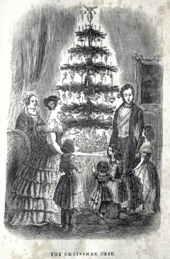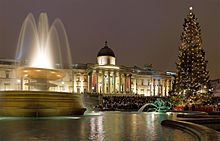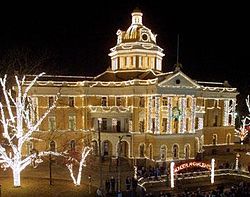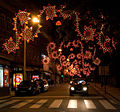- Christmas lights
-
This article is about the decoration. For the Coldplay song, see Christmas Lights (song). For the TV show, see Christmas Lights (television special).
Christmas lights are lights used for decoration around Christmas. The use of decorative, festive lighting during the Christmas holiday season is a long standing tradition in many Christian cultures, and has been adopted as a secular practice in a number of other non-Christian, or predominantly non-Christian, cultures (notably in Japan).
Contents
History
Early Christians were persecuted for having worship gatherings ("mass"). A candle in the window signified where worship would be occurring for Christians in a community.[citation needed]
The tradition of using small candles to light up the Christmas tree dates back to at least the middle of the 17th century. However, it took two centuries for the tradition to become widely established first in Germany and soon spreading to Eastern Europe.[1]
Candles for the tree were glued with melted wax to a tree branch or attached by pins. Around 1890, candleholders were first used for Christmas candles. Between 1902 and 1914, small lanterns and glass balls to hold the candles started to be used.[1]
The illuminated Christmas tree became a Christmas tradition in Germany during the Early Modern period. The illuminated Christmas tree became established in the United Kingdom during Queen Victoria's reign, and through emigration spread to North America and Australia. In her journal for Christmas Eve 1832, the delighted 13-year-old princess wrote, "After dinner..we then went into the drawing-room near the dining-room. There were two large round tables on which were placed two trees hung with lights and sugar ornaments. All the presents being placed round the trees".[2] Until the development of inexpensive electrical power in the mid nineteenth century, miniature candles were commonly (and in some cultures still are) used.
In the United Kingdom, electrically powered Christmas lights are generally known as fairy lights. In 1881, the Savoy Theatre, London was the first building the world to be lit entirely by electricity.[3] Sir Joseph Swan, inventor of the incandescent light bulb, supplied about 1,200 Swan incandescent lamps, and a year later, the Savoy owner Richard D'Oyly Carte equipped the principal fairies with miniature lighting supplied by the Swan United Electric Lamp Company, for the opening night of the Gilbert and Sullivan operetta Iolanthe on 25th November 1882.[4] The term fairy lights for a string of electrically powered christmas lights has been in common usage in the UK ever since.[5]
The first known electrically illuminated Christmas tree was the creation of Edward H. Johnson, an associate of inventor Thomas Edison. While he was vice president of the Edison Electric Light Company, a predecessor of today's Con Edison electric utility, he had Christmas tree light bulbs especially made for him. He proudly displayed his Christmas tree, which was hand-wired with 80 red, white and blue electric incandescent light bulbs the size of walnuts, on December 22, 1882 at his home on Fifth Avenue in New York City. Local newspapers ignored the story, seeing it as a publicity stunt. However, it was published by a Detroit newspaper reporter, and Johnson has become widely regarded as the Father of Electric Christmas Tree Lights. By 1900, businesses started stringing up Christmas lights behind their windows.[6] Christmas lights were too expensive for the average person; as such, electric Christmas lights did not become the majority replacement for candles until 1930.[7]
In 1895, U.S. President Grover Cleveland proudly sponsored the first electrically lit Christmas tree in the White House. It was a huge specimen, featuring more than a hundred multicolored lights. The first commercially produced Christmas tree lamps were manufactured in strings of multiples of eight sockets by the General Electric Co. of Harrison, New Jersey. Each socket took a miniature two-candela carbon-filament lamp.
From that point on, electrically illuminated Christmas trees, but only indoors, grew with mounting enthusiasm in the United States and elsewhere. San Diego in 1904 and Appleton, WI in 1909, and New York City in 1912 were the first recorded instances of the use of Christmas lights outside.[7] McAdenville North Carolina claims to have been the first in 1956.[8] The Library of Congress credits the town for inventing "the tradition of decorating evergreen trees with Christmas lights dates back to 1956 when the McAdenville Men's Club conceived of the idea of decorating a few trees around the McAdenville Community Center."[9] However, the Rockefeller Center Christmas Tree has had "lights" since 1931, but did not have real electric lights until 1956.[10] Furthermore, Philadelphia's Christmas Light Show and Disney's Christmas Tree also began in 1956.[11][12] Though General Electric sponsored community lighting competitions during the 1920s, it would take until the mid 1950s for the use of such lights to be adopted by average households.
Over a period of time, strings of Christmas lights found their way into use in places other than Christmas trees. Soon, strings of lights adorned mantles and doorways inside homes, and ran along the rafters, roof lines, and porch railings of homes and businesses. In recent times, many city skyscrapers are decorated with long mostly-vertical strings of a common theme, and are activated simultaneously in Grand Illumination ceremonies.
In the mid 2000s, the video of the home of Carson Williams was widely distributed on the internet as a viral video. It garnered national attention in 2005 from The Today Show on NBC, Inside Edition and the CBS Evening News and was featured in a Miller television commercial.[13][14] Williams turned his hobby into a commercial venture, and was commissioned to scale up his vision to a scale of 250,000 lights at a Denver shopping center, as well as displays in parks and zoos.
Technology
Main article: Christmas lighting technologyThe technology used in Christmas lighting displays is highly diverse, ranging from simple light strands, Christmas lights (aka Fairy lights in the UK), through to full blown animated tableaux, involving complex illuminated animatronics and statues.
Christmas lights (also called twinkle lights, holiday lights, and mini lights in the US and fairy lights in the UK), that are strands of electric lights used to decorate homes, public/commercial buildings and Christmas trees during the Christmas season are amongst the most recognized form of Christmas lighting. Christmas lights come in a dazzling array of configurations and colors. The small "midget" bulbs commonly known as fairy lights are also called Italian lights in some parts of the U.S., such as Chicago.
The types of lamps used in Christmas lighting also vary considerably, reflecting the diversity of modern lighting technology in general. Common lamp types are incandescent light bulbs and now light-emitting diodes (LEDs), which are being increasingly encouraged as being more energy efficient. Less common are neon lamp sets. Fluorescent lamp sets were produced for a limited time by Sylvania in the mid-1940s.[15]
Outdoor displays
The Marshall, Texas courthouse outlined in Christmas lights
Public venues
Displays of Christmas lights in public venues and on public buildings are a popular part of the annual celebration of Christmas, and may be set up by businesses or by local governments. The displays utilise Christmas lights in many ways, including decking towering Christmas trees in public squares, street trees and park trees, adorning lampposts and other such structures, decorating significant buildings such as town halls and department stores, and lighting up popular tourist attractions such as the Eiffel Tower and the Sydney Opera House.
Annual displays in Oxford Street, London, England are adored by the public and local businesses alike, have been erected for decades.
Neighborhoods
 Colorful Christmas light arrangement in a residential neighborhood in Champaign, Illinois.
Colorful Christmas light arrangement in a residential neighborhood in Champaign, Illinois.
In the U.S. from the 1960s, beginning in tract housing, it became increasingly the custom to completely outline the house (but particularly the eaves) with weatherproof Christmas lights. The Holiday Trail of Lights is a joint effort by cities in east Texas and northwest Louisiana that had its origins in the Festival of Lights and Christmas Festival in Natchitoches, started in 1927, making it one of the oldest light festivals in the United States.
It is often a pastime to drive or walk around neighborhoods in the evening to see the lights displayed on and around other homes traditionally called a Tacky Light Tour. While some homes have no lights, others may have incredibly ornate displays which require weeks to construct. A rare few have even made it to the Extreme Christmas TV specials shown on HGTV, at least one requiring a generator and another requiring separate electrical service to supply the amount of electrical power required.
In Australia and New Zealand, chains of Christmas lights were quickly adopted as an effective way to provide ambient lighting to verandas, where cold beer is often served in the long hot summer evenings. For many years the use of Christmas lights on Australian homes was mainly limited to this simple form. From about 1990 increasingly elaborate Christmas lights have been displayed and driving around between 8 and 10 p.m. to look at the lights has become a popular family entertainment. While in some areas there is fierce competition, with town councils offering awards for the best decorated house, in other areas it is seen as a co-operative effort, with residents priding themselves on their street or their neighbourhood.
Other holidays
In the United States, lights have been produced for many other holidays. These may be simple sets in typical holiday colors, or the type with plastic ornaments which the light socket fits into. Light sculptures are also produced in typical holiday icons.
Halloween is the most popular, with miniature light strings having black-insulated wires and semi-opaque orange bulbs. Later sets had some transparent purple bulbs (a representation of black, similar to blacklight), a few even have transparent green, or a translucent or semi-opaque lime green (possibly representing slime as in Ghostbusters, or creatures like goblins or space aliens). Two types of icicle lights are sold at Halloween: all-orange, and a combination of purple and green known as "slime lights."
Easter lights are often produced in pastels. These typically have white wire and connectors.
Red, white, and blue lights are produced for Independence Day, as well as U.S. flag and other patriotic-themed ornaments. Net lights have been produced with the lights in a U.S. flag pattern. In 2006 some stores carried stakes with LEDs that light fiber-optics, looking similar to fireworks.
These above light strings are occasionally used on Christmas trees anyway, usually to add extra variety to the colors of the lights on the tree.
Various types of patio lighting with no holiday theme are also made for summertime. These are often clear white lights, but most are ornament sets, such as lanterns made of metal or bamboo, or plastic ornaments in the shape of barbecue condiments, flamingos and palm trees, or even various beers. Some are made of decorative wire or mesh, in abstract shapes such as dragonflies, often with glass "gems" or marbles. Light sculptures are also made in everything from wire-mesh frogs to artificial palm trees outlined in rope lights.
In India, fairy lights are often used to decorate in celebration of Eid ul-Fitr, which occurs at the end of Ramadan. For example see the holiday decorations in the movie, Saawariya.
Light sculptures
Christmas light sculptures, also called motifs, are used as Christmas decorations and for other holidays. Originally, these were large wireframe metalwork pieces made for public displays, such as for a municipal government to place on utility poles, and shopping centers to place on lampposts. Since the 1990s, these are also made in small plastic home versions that can be hung in a window, or on a door or wall. Framed motifs can be lit using mini lights or ropelight, and larger scale motifs and sculptures may use C7 bulbs.
Light sculptures can be either flat (most common) or three-dimensional. Flat sculptures are the motifs, and are often on metal frames, but garland can also be attached to outdoor motifs. Indoor motifs often have a multicolored plastic backing sheet, sometimes holographic. 3D sculptures include deer or reindeer (even moose) in various positions, and with or without antlers, often with a motor to move the head up and down or side to side as if grazing. These and other 3D displays may be bare-frame, or be covered with garland, looped and woven transparent plastic cord or acrylic, or natural or goldtone-painted vines. Snowflakes are a popular design for municipal displays, so as not to be misconstrued as a government endorsement of religion, or so they can be left up all winter.
Some places make huge displays of these during December, such as Callaway Gardens, Life University, and Lake Lanier Islands in the U.S. state of Georgia. In east Tennessee, the cities of Chattanooga, Sevierville, Pigeon Forge, and Gatlinburg have light sculptures up all winter. Gatlinburg also has custom ones for Valentine's Day and St. Patrick's Day, while Pigeon Forge puts flowers on its tall lampposts for spring, and for winter has a steamboat and the famous picture of U.S. Marines Raising the Flag on Iwo Jima, in addition to the city's historic Old Mill.
Some sculptures have microcontrollers that sequence circuits of lights, so that the object appears to be in motion. This is used for things such as snowflakes falling, Santa Claus waving, a peace dove flapping its wings, or train wheels rolling.
Examples
-
LED light sculptures over ice skating rink in Nathan Phillips Square
-
Lisbon in 2005
-
LED light sculpture in Gänserndorf, Austria
See Also
Categories:- Christmas decorations
- Lighting
- Light sources
Wikimedia Foundation. 2010.























